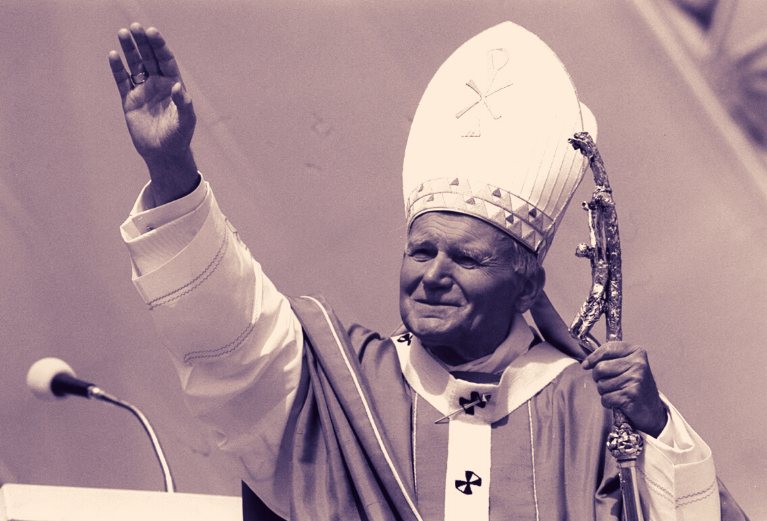Pure Gift: Day 11
Author: Andrew Comiskey
October 24, 2020
‘According to Genesis
2:25, the man and the woman “did not feel shame”; seeing and knowing each other
in all the peace and tranquility of the interior gaze, they “communicate” in
the fullness of humanity, which shows itself in them as reciprocal complementarity
precisely because they are “male” and “female.” At the same time, they “communicate”
based on their communion of persons in which they become a mutual gift for each
other, through femininity and masculinity. In reciprocity, they reach in this
way a particular understanding of the meaning of their own bodies. The original
meaning of nakedness corresponds to the simplicity and to the fullness of
vision in which their understanding of the meaning of the body is born from the
very heart, as it were, of their community-communion. We call this meaning “spousal.’’
(TOB 13:1)

‘One can say that, created
by Love, that is, endowed in their being with masculinity and femininity, both
are “naked” because they are free with the very freedom of the gift. This
freedom lies exactly at the spousal meaning of the body. The human body, with
its sex--its masculinity and femininity--seen in the very mystery of the
creation, is not only a source of fruitfulness and procreation, as in the whole
natural order, but contains “from the beginning” the “spousal” attribute, that
is, the power to express love; precisely that love in which the human person
becomes a gift and--through this gift--fulfills the very meaning of his
being and existence.’ (TOB 15:1)
Leanne Payne imprinted on
us something of the human creature’s nobility as discovered in vertical,
upright communion with its Creator. Taking our cues from God as to who we are and
how He indwells us, we can learn to listen to His still small voice. Payne
straightens us up, orients us heavenward. St. John Paul II majors on the
horizontal orientation of our humanity. In The Theology of the Body: Human Love
in the Divine Plan, the late pope fleshes out the intrinsic good of our gift-giving—man
to woman, woman to man.
For over four years, from
1980-1984, St. John Paul II gave a series of weekly lectures at the Vatican on the
marvelous meaning God has purposed for our sexual humanity. (TOB is the sum of
these lectures.) He was equipped for the task. His love of love—a serious yet
buoyant commitment to parsing how human love intersects with the mystery of
Jesus’ love for us--directed him as a young man to major in both theological
anthropology (humanity made in God’s image) and philosophy (defining human
freedom in sexual love). That freedom took on new expressions in the sixties
with the sexual revolution. When Protestants of all stripes debated
contraception and conceded to it, most assumed that the Catholic Church, fresh
from its season of Vatican 2 reforms, would welcome the ‘pill’ as well.
Surprisingly, Pope St. Paul VI wrote Humanae Vitae and insisted that every
marital sexual act had to remain open to ‘life.’ He insisted that sexual union,
with all of its emotional and sensual benefits, shouldn’t be manipulated with
devices and chemicals as to bar such union from the prospect of children.
Shocking. Divisive.
St. John Paul II wrote the
much larger work of TOB for the purpose of surrounding Humanae Vitae with a
loving biblical theology. He basically takes Jesus’ main sayings on marriage
and sexual love then interpenetrates them with related verses in the Old and
New Testaments. What emerges is a clear yet layered take on how man and woman
in Christ must proceed onward in love. Specifically, that means cultivating an
orientation toward dignifying the whole of the other’s intrinsic value as man
or woman. Anchored in our bodies, St. John Paul II insists that we exercise our
freedom as image-bearers to integrate our ‘urge to merge’ with love for a whole
person.
As today’s passages from
TOB reflect, St. JP ll, starting with Jesus’ words on marriage in Matt. 19:4-6,
takes us back to the garden where he grants us a glimpse of our original
innocence. Free from shame, undivided by lust, we can offer our very essence as
‘body’ people in ‘spousal love.’ That term comes up often in TOB. It means that
the body is a gift in its particularly masculine or feminine expression. It is
not a curse, a liability, an object. It is a person endowed with a blessedly sexual
dimension designed to give love to another.
Spousal love is linked to
the ‘freedom of the gift.’ Made in His image, we are designed to offer our
‘gift’ in a way that liberates all involved. We nuance freedom east of Eden. But
at this stage of TOB, St. John Paul II wants us to savor our roots, our
shame-free foundations as humanity made for love. He made us His gifts for each
other, endowed with the freedom to offer ourselves wholly, in love, and to bring
forth children, the fruit of love.
‘Thank You Jesus that You
take us back to the garden where we can still behold Your best for us. We ask
for help to grasp that our bodies are still gifts, still designed to give love
and receive love. Forgive us for majoring more on original sin than on the
original innocence of our ‘gifted’ bodies.’
‘Jesus, please confirm Amy Coney Barret to the
US Supreme Court.’
BACK